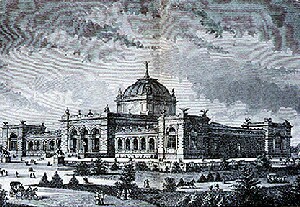|
1 |
 Copyright: McCabe 1876, S. 53 |
|
1 |
 Copyright: McCabe 1876, S. 53 |
Joaquin Miller: Song of the Centennial
The Minstrel Sings:
Peace on earth and harvest time!
Hail the day, but heal the scars!
Heavens blue, yon bannered stars
Blending in the far sublime,
Sing Peace on earth and harvest time!
Peal the cannon! Clang the bell!
Wave the banners! Bow and pray.
Turn in gratitude to-day
To mighty men who fought and fell-
To Him who doeth all things well.
Peace on earth and harvest time!
The farmer sings; the battle-field
Bears on her breast a gleaming shield
Of corn that clangs in rippled rhyme-
Lo! peace on earth and harvest time!
Source: Illustrated Historical Record of the Centennial Exhibition. New York 1878.
Franz Reuleaux: Concerning the site and the German contribution
The impression as a whole is determined to a large extent by the “Centennial” site’s sheer size. “Centennial” is the word of the day, the third word in every conversation, the second in the local press. Anything thinkable is called Centennial; the carts, the flags, the taverns, they all carry this word written somewhere; there is Centennial pomade, Centennial soap, Centennial beer.
Centennial Ground is the name of the most splendid, fresh, green park, in which the festival buildings are situated. […] Imagine the whole exhibition site, which encompasses 115 hectares, as cut out of an immense park directly wrestled from nature; softly rolling hills, divided by two deep ravines that several bridges cross – and all in great impressive dimensions; add clusters of old trees heavy with leaves next to low thickets; the most delicate loveliness interspersed amongst significant, self-complementary shapes of landscape. Imagine all this and you will have an idea of the modern Altis?, on which the industrial competition takes place.
Our German pavilion is situated towards the front of the most beautiful landscape of the site and, in virtue of its nice, if simple, form and its fine friendly interior, receives a lot of praise. In the evenings, when we German members of the jury tiredly find ourselves on the way home and our eyes wander across the peaks, turrets and galleries of the exhibition town, glittering in the light of the evening sun, this sight repays many of the day’s toils and helps us forget that, with respect to the exhibition itself, Germany has remained so far behind our wishes. And it must not be concealed, indeed it must be said aloud, that Germany has suffered a severe defeat at the exhibition in Philadelphia.
Source: Franz Reuleaux: Letters from Philadelphia. Braunschweig 1877
Henry Adams: My visit to the world exhibition
By my soul, I hate these big shows. […] This one is bigger, louder, busier and its contents are even more uniform and vulgar than those of any of its predecessors. I enjoyed the exhibition because I had pleasant company. But I have sworn an oath never again to visit one of these dreadful performances. The crowds there were terrifying, and there were many diseases and upsets. […] Many caught typhus and unless you are very lucky, you will also catch a yellow fever.
From a letter to Charles M. Gaskell, 1876
| Year: 1876 | City: Philadelphia | Country: USA |
| Duration: 10th May - 10th November 1876 | ||